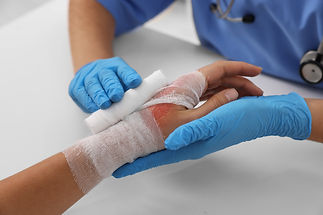
Burn Therapy
Most minor burns can be treated at home. They usually heal within a couple of weeks. For serious burns, after appropriate first aid and wound assessment, your treatment may involve medications, wound dressings, physical therapy and surgery. The goals of treatment are to control pain, remove dead tissue, prevent infection, reduce scarring risk and regain function. Skin quality and aesthetic appearance following a burn, while secondary to these primary factors, is also important and requires a specialized approach. HYPPP Therapy is both clinically safe and effective in the treatment of severe burns, and it may help to avoid the need for extensive surgical reconstructive procedures.
People with severe burns (e.g. second and third-degree burns) may require treatment at specialized burn centres. They may need extensive surgical debridement and skin grafts to cover large wounds. They may also need emotional support and months of follow-up care, such as physical therapy, in order to return to daily activities.
After you have received first aid for a major burn, your medical care may include medications and treatments that are intended to encourage recovery and wound healing. These may include:
-
Drugs that fight infection. If you develop an infection, you may need IV antibiotics.
-
Fluids to prevent dehydration. You may need intravenous (IV) fluids to prevent dehydration and organ failure.
-
Pain and anxiety medications. Healing burns can be incredibly painful. You may need morphine and anti-anxiety medications, particularly for dressing changes.
-
Tetanus shot. Your doctor might recommend a tetanus shot after a burn injury.
-
Water-based treatments. Your care team may use techniques such as ultrasound mist therapy to clean and stimulate the wound tissue.
-
Burn creams and ointments. If you are not being transferred to a burn centre your care team may select from a variety of topical products for wound healing, such as bacitracin and silver sulfadiazine (Silvadene). These help prevent infection and prepare the wound to close.
-
Wound Dressings. Your care team may also use various specialty wound dressings to prepare the wound to heal. If you are being transferred to a burn centre, your wound will likely be covered in dry gauze only.

You may need one or more of the following medical procedures:
-
Breathing assistance. If you've been burned on the face or neck, your throat may swell shut. If that appears likely, your doctor may insert a tube down your windpipe (trachea) to keep oxygen supplied to your lungs.
-
Feeding tube. People with extensive burns or who are undernourished may need nutritional support. Your doctor may thread a feeding tube through your nose to your stomach.
-
Easing blood flow around the wound. If a burn scab (eschar) goes completely around a limb, it can tighten and cut off the blood circulation. An eschar that goes completely around the chest can make it difficult to breathe. Your doctor may cut the eschar (escharotomy procedure) to relieve this pressure.
-
Skin grafts. A skin graft is a surgical procedure in which sections of your own healthy skin are used to replace the scar tissue caused by deep burns. Donor skin from deceased donors or animal-derived substitutes can be used as a temporary solution.
-
Plastic surgery. Plastic surgery (reconstruction) can improve the appearance of burn scars and increase the flexibility of joints affected by scarring.
Physical and occupational therapy
If the burned area is large, especially if it covers any joints, you may need physical therapy exercises. These can help stretch the skin so that the joints can remain flexible. Other types of exercises can improve muscle strength and coordination. And occupational therapy may help if you have difficulty doing your normal daily activities.
Currently, there is limited availability of bioactive skin repair treatments, while most wound dressing materials available merely provide protection against infection and lubrication to the wound. HYPPP Therapy is an advanced treatment for burns that actively promotes skin repair through the stimulation of new blood vessel development and cell proliferation into the wound area. Clinical data shows that even full-thickness large wounds can heal within 2-4 months under treatment with HYPPP Therapy. In certain cases, the application of HYPPP Therapy to a burn wound may help avoid the need for skin grafting or extensive plastic reconstructive procedures. The treatment is initiated following a surgical debridement of the wound by your physician, and carried out by patients at home, as it is easily applied to the wound daily.
Contact
If you are suffering from a burn injury please send us an inquiry and we will get back to you asap.
